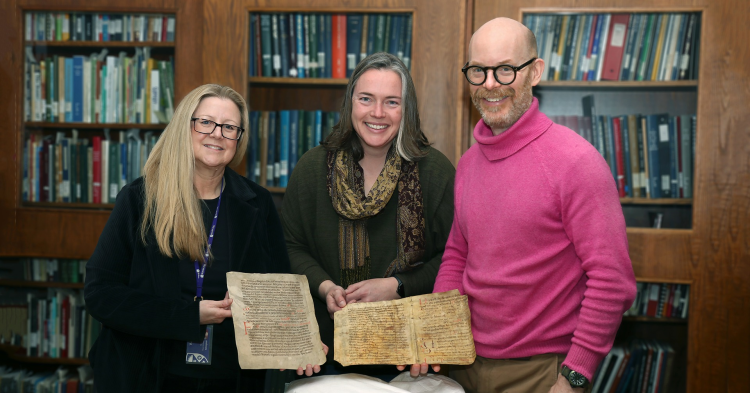Special collections librarian Deborah Meert-Williston said she couldn't believe what she was seeing when she first noticed "little squiggle" markings above the text in pages of manuscript waste, obsolete documents repurposed as bindings or reinforcement materials in medieval books. The reused materials can yield historical gems, and Meert-Williston was quick to spot some while searching manuscripts online.

Western's Archives and Special Collections Library now houses two early examples of written medieval music. (L to R) Librarian Deborah Meert-Williston, music professor Kate Helsen and music library director Brian McMillan display the two parchment documents containing medieval nuemes. (Colleen MacDonald/Western News)
"I took action right away," she said of eagerly emailing photos of the parchment pages to Western music professor Kate Helsen.
Meert-Williston's enthusiasm was matched by Helsen, who dropped what she was doing to immediately confirm the findings as medieval neumes, one of the earliest forms of written music.
"We didn't have any at Western," Helsen said of the neumes. "They're rare enough that I got super excited when I thought, We could actually have them in our collection.'"
The neumes offer a glimpse into the medieval age when people were just beginning to conceive of how music could exist in a written form. Unlike modern sheet music that uses notes arranged vertically on a five-line staff to indicate pitch, the neumes are adiastematic, meaning they lack a vertical arrangement of notes.
"They show melodic direction and rhythmic patterns without specifying an exact pitch. You can't sight-read these neumes," Helsen explained. "The people who were singing from them already had the music in their head. This was their little shorthand for how to remember the melody."
Medieval music built from memory and oral tradition
Neumes of this type originated in the ninth century, yet they were discovered in texts likely dating to the 12th century. Helsen believes these pages came from monasteries in southern Germany, Switzerland or Austria.
"Great importance was placed on internalizing the music in these places," Helsen said. "We know this because we've found chants composed for the 12th century saint Thomas Becket in diastematic form - with notes on a staff line - that were later retrofitted into adiastematic notation without staff lines, to ensure the monks would memorize the music."
Only in the last 20 years have music researchers discovered memorization of the melodies was valued enough in some regions that the oldest neumes endured for centuries after they were abandoned elsewhere. Scholars like Helsen are especially intrigued by what these documents can tell us about the evolution of music.
"I've studied this for a long time because I can't stop thinking about how fascinating it is to imagine music like it was in other people's heads. Neumes are the closest thing I've ever encountered to being an actual transcription of an intangible idea in someone's mind."
Kate Helsen, professor in Western's Don Wright Faculty of Music
Helsen said neumes reveal how the origins of music in the Western world are actually much closer than once believed to musical evolution in Eastern cultures, where music was developed through generations of oral tradition and learning by ear.
"Nine hundred years ago, they didn't teach music by using a rigid set of rules like we do now. They took the words they'd already memorized and added musical notations to find pleasing riffs and little melodies and then built on them with more pieces. They were creating music from the inside out."
Rare addition to Western's medieval music collection
Though fragments with neumes exist in various collections globally, complete pages are rarer. Western's first-ever acquisition of these documents came after Meert-Williston reached out to Brian McMillan, director of Western's Music Library. He enthusiastically agreed to support buying two documents from the Ontario vendor, a purchase made possible by legacy donors to Western Libraries
The documents, now housed in Western's Archives and Special Collections, are a valued addition to the university's extensive collection of medieval music. They will open new avenues of research, while giving students and researchers hands-on access to early musical history, Helsen and Meert-Williston said.
"What makes them special is that they're real - not just theory in a class but tangible pieces of the history that shaped how written music was conceived," Helsen said.
Meert-Williston knows firsthand the exhilaration of connecting theory with a genuine artifact. Years before, she took a class in early musical notation in medieval manuscripts to supplement her knowledge as a librarian.
"I was only able to recognize what I was seeing as neumes because of that course. Seeing them for real was thrilling. That moment took me from theory to reality, and now we can do that for our students too."
To make these neume fragments come alive even further for modern audiences, Helsen developed a project she calls a "sound walk," which features posters with images of the fragments paired with sound beacons linked to a smartphone app. That allows visitors to hear the chants as they approach each one. The project is one of several medieval musicology projects in the Digital Analysis of Chant Transmission partnership.
Helsen will be presenting her third sound walk at the International Congress on Medieval Studies at Western Michigan University in May. It will be her first one to feature a fragment with notations found in the earliest neumes. They are especially challenging to present because modern musicians don't have the melodies memorized like the medieval monks did.
"We get so used to long-standing innovations in our world, like sheet music, that we forget there was a time when it was a momentous discovery. Sharing music with others without vocalizing it was truly momentous. And now Western has actual examples of the earliest efforts to capture music."










